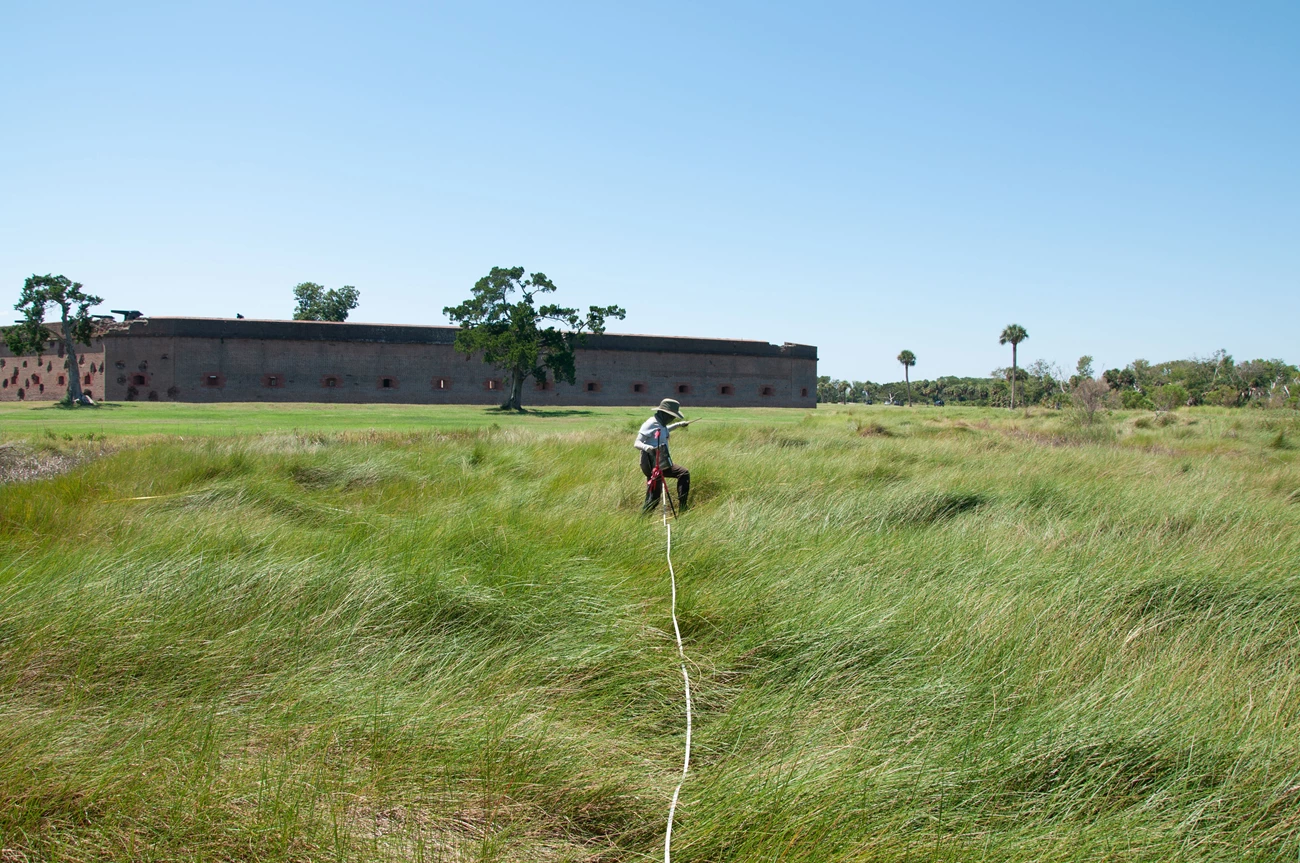
NPS photo / M. Forbes Boyle

NPS Photo
Overview
Fort Pulaski National Monument is located east of Savannah, Georgia, near the mouth of the Savannah River. The 2,276-hectare (5,623-acre) monument is comprised of two islands: Cockspur Island to the north, and McQueen’s Island to the south. Undeveloped portions of Cockspur Island are presently dominated by Eastern Red Cedar (Juniperus virginiana)/Live Oak (Quercus virginiana)/Cabbage Palmetto (Sabal palmetto) Marsh Hammock. McQueen’s Island is less developed and is primarily in salt marsh cordgrass (Spartina alterniflora) cover. Both islands have experienced anthropogenic alterations, since at least the 1700s. In the 1820s, construction began on Fort Pulaski on Cockspur Island, and additional drainage ditches and dredge spoil deposits followed in later years. Due to the park’s location at the mouth of the Savannah River, direct and indirect effects of contaminants affect water quality in the watershed. Ship traffic and dredging also contribute to shoreline erosion issues on the north side of Cockspur Island.
The Southeast Coast Network conducts the following monitoring at Fort Pulaski National Monument
- Water-quality monitoring is conducted in the estuarine waters near Fort Pulaski National Monument. To effectively monitor a diverse and dynamic set of estuarine water resources, the network implements a two-pronged monitoring approach consisting of a fixed-monitoring stations and parkwide assessments. This gives a more complete picture of physical processes, diurnal and seasonal variations, and spatial patterns during critical portions of the year. The fixed station, located in Lazaretto Creek, is equipped with a sonde that measures depth, dissolved oxygen, pH, salinity, turbidity, and water temperature every 30 minutes. In addition, monthly samples are collected to evaluate nutrient levels and water clarity. These data help determine if there are excess nutrients in the estuary that are harmful to fish, oysters, and other animals. Water-quality data from the sonde are available on the Aquarius web portal and nutrient data are available from the Water Quality Portal. Parkwide water quality assessments are conducted every five years at 30 randomly selected estuarine sites and evaluate the same parameters monitored at fixed stations. In addition, sediment samples are collected every ten years and analyzed for metals and organic contaminates. Water-quality monitoring at Fort Pulaski National monument has been ongoing since 2006.
- Salt marsh elevation monitoring sites are surveyed twice annually during spring and fall. Salt marshes and coastal wetlands habitats host a wide diversity of wildlife and are important to many aquatic species but are threatened by sea-level rise. The marshes must grow at a rate equal to or greater than the rate of sea level rise, or they will eventually disappear. The network measures salt marsh elevation and investigates the rate of accretion or subsidence (growth or reduction) in these areas. Salt marsh elevation monitoring at Fort Pulaski National Monument has been ongoing since 2014.
- Landbird community monitoring and Vocal anuran community monitoring is conducted on a rotating schedule every three years. These wildlife communities play critical roles in park ecosystems and interact with several trophic levels of food webs. The network uses automated recording devices (ARDs) to collect vocalization data during mornings and evenings in the spring, which are analyzed by bioacoustics specialists. Data collected from these vital sign monitoring efforts help assess the ecological integrity and diversity of park areas and how communities and park conditions may change over time. The landbird and vocal anuran monitoring efforts in network parks began in 2012.
- Vegetation community monitoring is conducted on a rotating schedule. Monitoring vegetation is important because it’s key indicator of overall ecosystem health. Changes in vegetation reflect the effects of stressors like extreme weather, disease, invasive species, fire, and land use change. Plant communities also provide structured habitat and food resources for other species. Vegetation monitoring data provides managers with information about the degree of change in their park’s natural communities. Vegetation plots have been established across the following habitats: Maritime Tidal Wetlands and Maritime Upland Forests and Shrublands. Data reports include information about new occurrences and rare plants, species richness and abundance, tree health and regeneration, disturbance observations, soil nutrients, landform/geomorphology, and downed woody debris.
| Vital Sign | Examples of Measurement |
|---|---|
| Estuarine Water Quality | pH, temperature, dissolved oxygen, conductivity |
| Salt Marsh Elevation | Magnitude, rate and within-site variability of surface elevation, sediment accretion or erosion, different drivers |
| Landbird and Vocal Anuran Communities | Species occurrence, distribution |
| Terrestrial Vegetation Communities | Plant community diversity, relative species/guild abundance, structure/age class, incidence of disease |
Source: NPS DataStore Collection 3990 (results presented are a subset). To search for additional information, visit the NPS DataStore.
Source: NPS DataStore Collection 3985 (results presented are a subset). To search for additional information, visit the NPS DataStore.
Source: NPS DataStore Collection 3986 (results presented are a subset). To search for additional information, visit the NPS DataStore.
Source: NPS DataStore Collection 9583. To search for additional information, visit the NPS DataStore.
Source: NPS DataStore Collection 3992 (results presented are a subset). To search for additional information, visit the NPS DataStore.
Source: NPS DataStore Collection 3991 (results presented are a subset). To search for additional information, visit the NPS DataStore.
Source: NPS DataStore Collection 3989 (results presented are a subset). To search for additional information, visit the NPS DataStore.
Last updated: November 11, 2024
